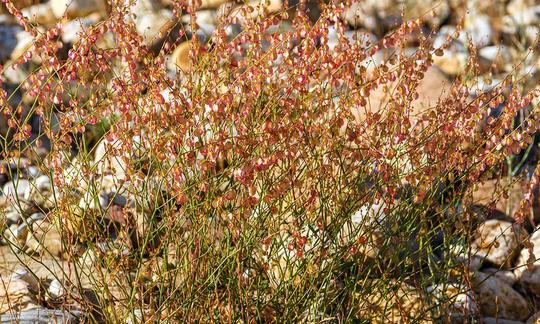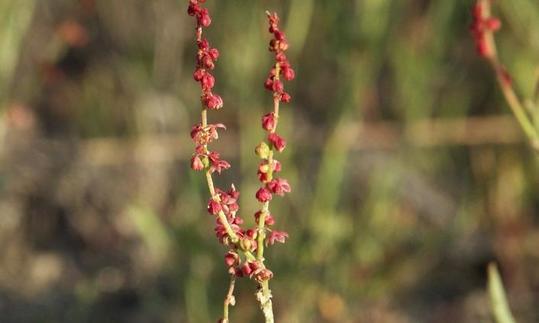Table of contents
Small sorrel ( Rumex acetosella ), also known as small dock or dwarf sorrel, tastes sour due to the oxalic acid it contains. It is used raw as a vegetable or as a seasoning ingredient. When buying, make sure it is organic .
Small sorrel: Use in the kitchen
Is small sorrel edible? The leaves of this type of sorrel are considered a classic wild vegetable and are a component of Frankfurt green sauce . The sorrel taste is lemony and sour. This makes the raw wild plant an alternative to lemon juice or vinegar .
Can you eat sorrel raw? Basically, small sorrel is edible raw. There is nothing wrong with eating it irregularly or in small quantities.
The oxalic acid content is comparable to that of rhubarb . By soaking, boiling and throwing away the cooking water, the water-soluble oxalic acid can be reduced by 30-87%. 20
How can you eat sorrel? Young leaves taste like salads with a slightly bitter note, e.g. radicchio or rocket . Raw, they taste great in vegan spreads, finely chopped as a spice or as a salad ingredient (raw food), hence the name salad sorrel. Cooked, the leaves go well in dishes such as soups, sauces, omelettes or spinach. Short cooking times are recommended, otherwise the leaves turn brown and collapse. The herb should not be cooked in pots containing iron, as this gives it a metallic taste. Dishes with sorrel can be combined with lentils , potatoes , tomatoes , cucumbers and zucchini . Young leaf stalks can be used like rhubarb to make compote and fruit cake. Older leaves and leaf stalks have a slightly bitter note; 1,2 the older the leaves and the redder the color, the more oxalic acid they contain. 10
Is the sorrel flower edible? Flowering sorrel, flower buds and young shoots taste spicy and are suitable for cooking and as an aromatic ingredient. They go well raw with sauces, dips or vegan herb butter or vegan herb curd.
Is sorrel root edible? Dried roots are used to make tea or ground to make flour. You can also eat the seeds. They are used as seedlings or to make tea.
The combination of sorrel or soursop (dialect) with calcium-rich foods is beneficial, as this binds the free oxalic acid. Suitable examples include sesame and dried herbs such as basil , marjoram , thyme , dill , oregano , rosemary , coriander leaves , fennel seeds , parsley or tarragon .
Recipe for fresh sorrel tea:
To make the tea, pour 2 teaspoons of fresh herb into 250 ml of boiling drinking water . After letting it steep for 10 minutes, strain the wild herbs. For internal use, drink 2 cups of sorrel tea per day. Externally, this tea recipe can be used undiluted for skin washing. 3
Vegan sorrel recipes can be found under the note: " Recipes that have the most of this ingredient ".
| Not only vegans or vegetarians should read this: Vegans often eat unhealthily. Avoidable nutritional mistakes . |
Shopping - where to buy small sorrel?
Where can you buy sorrel? The wild vegetable is available seasonally in raw quality (raw food quality) in individual organic shops, health food stores, natural food stores, at the weekly market, directly from the farmer, in greengrocers, online or via a subscription box (seasonal box, green box).
Where can you buy fresh sorrel? Russian grocery stores sell the raw wild vegetable (organic quality?) all year round. In some countries, such as Hungary, sorrel is pureed and sold frozen. As a Polish speciality, sorrel can be bought in a jar.
Sorrel - where to buy? We have not yet found any fresh or processed sorrel in supermarkets such as Coop , Migros , Denner , Volg , Spar , Aldi , Lidl , Rewe , Edeka or Hofer , nor in the organic supermarkets Denn's Biomarkt or Alnatura .
Found in the wild - Season:
How can you identify sorrel? Rumex acetosella is an indicator plant for acidic soils that are poor in lime, nitrogen and nutrients. It is mainly found in lean and dry grasslands (madgrass drifts), dwarf shrub heaths, ruderal areas, roadsides and forest clearings. 2,4 It is better not to pick the wild plant from over-fertilized meadows.
Is the small sorrel small? The small sorrel is a clump-forming plant, 10-40 cm high, with pale green, angular stems that rise in an arch. The characteristic arrow-shaped leaves are very narrow and tapered. At the base they have two protruding, partially folded tips. The basal leaves have long stalks. Further up, the leaves sit directly on the stem. The inconspicuous flowers have a reddish to brownish tint and are in loose spikes on leafless, apical whorls. The shiny, dark brown fruits are three-edged, tiny nuts with a size of less than 2 mm. 2,3,5
Sorrel season: The main flowering period is from May to July. The leaves can be harvested from March to October, 2 although the ideal time to harvest is shortly before or at the beginning of the flowering period. The herb is cut just above the ground and can be bundled for drying. As the plant is very juicy, it is recommended to dry it using artificial heat, 3 but drying can lead to a loss of aroma (see below). The seeds can be harvested in late summer.
In spring, there is a risk of confusion with the poisonous arum . You can find more detailed information in the chapter "Risk of confusion - Possible confusion".
Storage:
Can you dry sorrel? It is not particularly suitable for drying as it loses a lot of its flavour. Raw, washed and spun dry, it can be stored in a plastic bag in the fridge for a few days. How can you preserve sorrel? and Can sorrel be frozen or pickled? Preservation options include freezing (in water) - or pickling in oil or water, salt and vinegar.
Sorrel: Ingredients - Nutritional values - Calories
100 g of Rumex acetosella contain 3.1 g of carbohydrates, 3.2 g of proteins and 0.36 g of fats with a calorie content of 26 kcal. 6
In addition to the main nutrients, the herb of dock ( Rumex ) contains vitamin C (117 mg/100g), vitamin A (1250 µg/100g), carotene, tannins and free oxalic acid. The latter fluctuates greatly over the course of the year. 2,6 The roots contain laxative anthranoids. 8
Fresh wild vegetables that are also rich in vitamin C and which cover more than the daily requirement with 100 g of consumption are: raw garlic mustard (261 mg/100g), raw wild garlic (150 mg/100g) or raw ground elder (140 mg/100g). 6,7
Other ingredients known for Rumex acetosella include primary potassium oxalate (potassium bioxalate), calcium oxalate, tartaric acid and anthraquinones (rutin and hyperoside). 9
In addition to dock, spinach and rhubarb have a significant amount of oxalic acid. The concentration varies in different parts of the plant. The stems of these plants contain significantly lower amounts than the leaves. 1
The complete ingredients of sorrel, the coverage of the daily requirement and comparison values with other ingredients can be found in our nutrient tables in CLICK FOR below the ingredients picture.
Small sorrel: healing effects - health aspects
Does sorrel have any health effects? The wild plant is not a scientifically recognized phytopharmaceutical. Before clinical trials can be carried out on patients, pharmacological studies are required to research the mechanism of action, safety and the effect of sorrel. Due to a lack of scientific data, conventional medicine, in contrast to folk medicine, does not use this plant. 3,9
Dangers - Intolerances - Side effects:
Small dock can have harmful effects on the body if consumed in large quantities due to the oxalic acid it contains. Particular caution is therefore required for children, people with kidney disease and people who are prone to urinary stones. The body cannot break down oxalic acid and excretes it through the kidneys. Pregnant women should refrain from using it. 1,2,9
Oxalic acid and its alkaline salts are slightly toxic. Consequences can include vomiting, diarrhea, difficulty swallowing and difficulty urinating. Larger amounts can be dangerous. The dosages given must be observed. 3 The lethal dose for pure oxalic acid is 5-15 g. Evidence mentions a fatal poisoning from the ingestion of around 6-8 g of oxalic acid in a soup made from 500 g of sorrel. However, the occasional consumption of plants with a high oxalic acid content does not pose a health problem for healthy people. 1
If consumed frequently, it should be noted that oxalic acid is an anti-nutritional substance that can significantly reduce the bioavailability of minerals ( calcium , magnesium , iron ). An unbalanced diet with a high intake of foods containing oxalic acid can promote a mineral deficiency. 1
By adding calcium-containing foods, part of the free oxalic acid binds to calcium and is therefore harmless. This has been shown by studies on healthy people. By increasing calcium intake from 200 to 1200 mg per day, the intestinal absorption rate of oxalic acid (absorption via the small intestinal mucosa) could be reduced from 16.9 to 2.6%. 1
Folk medicine - natural healing:
Is sorrel healthy? Edible sorrel species are traditionally used for blood purification, as a diuretic, to strengthen the immune system, to promote digestion and bile secretion, and to treat urinary retention. Externally, poultices are used for skin diseases and diseases of the oral mucosa. 2,3
In addition to the leaves, the roots are also often used for medicinal purposes. In the past, these were used to make a decoction for the internal treatment of blood disorders, jaundice, stone disease, skin disorders and internal bleeding. Depending on the anthraquinone and tannin content, the roots were used to treat diarrhea and as a laxative. 2.9
The ancient Romans and Egyptians used the so-called sorrel knotweed as a medicinal and edible plant. Later, it was eaten especially in times of scarcity. Due to its high vitamin C content, it was used to counteract vitamin deficiency diseases such as scurvy. 10
Sorrel: Occurrence - Origin - Ecology
The original distribution area of the dwarf sorrel includes the temperate and arctic regions of Europe, Asia and North Africa. In North and South America and Australia, the wild plant is a neophyte. 11
Dock species such as Rumex acetosa , Rumex acetosella , Rumex obtusifolius , Rumex alpinus or Rumex crispus are the main problem plants in the Alpine region. In a favourable sorrel location, they can spread in large numbers across grassland areas and displace forage grasses. Studies on the germination capacity of dock seeds (e.g. Rumex obtusifolius ) have shown that they are very robust and remain viable in liquid manure or dung, provided that the manure and dung are not fermented or composted. 21
Growing sorrel in the garden or as a pot plant:
Dwarf sorrel can be planted in a sunny, dry location. As an indicator of leanness, it prefers sandy, low-lime, acidic and nutrient-poor soils. 4 Can sorrel survive the winter? The hardy plant does not require any special winter protection.
Is small sorrel a weed? The plant is considered a weed because of its invasive spread. How can you grow sorrel? If you want to avoid the weed-like spread in the garden, you can plant sorrel in a flowerpot. If you want to sow it, pots are also preferable to garden beds. Tall pots are important so that the long roots have enough space. It is advisable to cut off the withered flower heads to prevent them from spreading seeds.
How can you control small sorrel? and Can you control sorrel organically? For sustainability reasons, biological or mechanical control is preferable to chemical control. Small sorrel: Can you control it? If you want to control Rumex acetosella in the garden, you can immediately dig out new rosettes, completely dig out rhizomes, keep the lawn short or scald the top 10-15 cm of the taproot with at least 1.6 l of hot water (80 °C). Controlling sorrel with vinegar? On unsealed surfaces, e.g. meadows or garden beds, vinegar is permitted as a household remedy for weed control. The vinegar is poured undiluted over the plant when it is about to flower, which then burns in the sun. 12
Where can you buy sorrel plants or seeds? Hardware stores, nurseries and garden centers offer potted plants and seeds, including organic seeds.
Typical fungal diseases on Rumex leaves are Peronospora rumicis and the rust fungi Puccinia phragmitis var. phragmitis , Uromyces acetosae , Puccinia acetosae and Uromyces rumicis . 13,14
The metallic green or green-blue shiny dock leaf beetles occasionally eat small holes in the leaves. They lay their yellow eggs on the underside of the leaves. Black, very voracious larvae hatch from them. In the event of an infestation, the animals and eggs can be seen. 15
Animal protection - species protection - animal welfare:
The so-called sour grass is a food plant for various butterfly caterpillars, 16 e.g. the copper butterfly, the dock green burnet, the alpine green burnet, the violet copper butterfly, the brown copper butterfly, the small copper butterfly and the goldfinch butterfly. Some moths feed exclusively on dock species. The seeds serve as food for birds. 4
The flowering period is from May to July, meaning that the nectar is collected in early to mid-summer. Nectar is the general term for the food that the bees bring in, i.e. nectar, pollen and honeydew. The flowers of the dwarf sorrel do not contain any nectar and the pollen value is medium (nectar value and pollen value scale: none, low, medium, high, very high). 17
Danger of confusion - possibilities of confusion:
There is a possibility of confusion with other edible dock species , e.g. with the mountain sorrel, the panicle sorrel or the chard-like blood sorrel (red sorrel). The small sorrel can be distinguished from other, usually much larger-leaved Rumex species by its narrow lanceolate leaves and the pronounced arrow shape. A closer look is necessary because of possible confusion with the meadow sorrel ( Rumex acetosa ), as the leaves are very similar in width and the downward-facing leaf corners. 2
Be careful not to confuse it with the poisonous spotted arum ( Arum maculatum ) or with other species of arum ( Arum ). As long as the plants have not developed flowers, the very narrow leaves of Rumex acetosella , which in spring are more reminiscent of rocket, and the broader leaves of the arum serve as identification features. 2 Later in spring, the flowers are the most important distinguishing feature. The arum forms its characteristic flowers close to the ground, while dwarf sorrel flowers grow upwards in panicles and are reddish. 18
General information:
What is sorrel? Small sorrel ( Rumex acetosella syn. Acetosella vulgaris ) is one of around 200 Rumex species and belongs to the knotweed family (Polygonaceae). It is a wild flower with leaves that contain oxalic acid.
The Latin name Rumex can be translated as "javelin" (curved sling weapon) 19 and refers to the leaf shape of the plants in this genus. The specific epithet acetosella refers to the sour taste.
How do you pronounce sorrel? It is a compound word that is pronounced as follows: [ˈzaʊ̯ɐˌʔamp͡fɐ].
Alternative names:
Synonymous names are dwarf sorrel, small sorrel, sorrel, sorrel (Saxony), sour sorrel (Switzerland), salad sorrel, sour grass or sour knotweed.
Incorrect spellings are sour amphibian, small meadow sorrel, sorrel, Dsauerampfer, sorrel or sorrel.
In English, the wild plant is called common sorrel. Alternative names are field sorrel, red sorrel, sheep sorrel, sheep's sorrel, sorrel or sour weed (sour weeds). Kuzukulağı (kuzu kulaği, kuzu kulak, kuzukulak) is the Turkish name.
Keywords for use:
The plant juice is used or was used to remove rust, mold and ink stains from linen, wood, silver and wickerwork; 5 the roots are suitable for dyeing.
Literature - Sources:












Comments